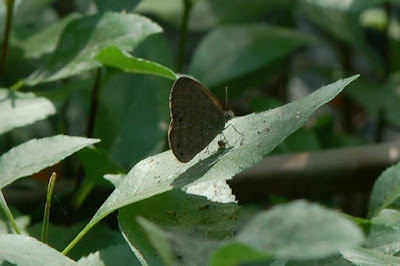I recently got back from a trip to Oklahoma and Texas. I was eager to see what butterflies I could stir up and although this time of year isn't peak for diversity, I still managed several new things. Here are some photos roughly organized by groups....
SWALLOWTAILS:
As usual with south Texas, GIANT SWALLOWTAILS were abundant. Some other species I saw on my trip included BLACK SWALLOWTAIL and SPICEBUSH SWALLOWTAIL. These were pretty familiar species to me so I didn't take many pictures of them.
WHITES & SULPHURS:
It was nice to have a break from Cabbage Whites (they don't occur in south Texas). Instead, I saw CHECKERED WHITE only once:
The only other white I saw was the common GREAT SOUTHERN WHITE:
Moving on to sulphurs, LITTLE YELLOWS were common:
I tried to find a Mimosa Yellow but never could. The closest I came was this butterfly that shows at least one black spot at the base of the hindwing below (Little Yellow should have two). However, Mimosa Yellow is said to not have any black spots at the base of the hindwing. Thoughts?
It took me awhile to figure out what these were, but I believe these plain yellow butterflies were LYSIDE SULPHURS:
Another new sulphur for me was this huge LARGE ORANGE SULPHUR:
Thankfully I caught up to one later in the trip to confirm it:
HAIRSTREAKS:
There wasn't a huge diversity of hairstreaks during my visit. The vast majority of hairstreaks were the abundant GRAY HAIRSTREAKS:
I did manage a lifer hairstreak though; MALLOW SCRUB-HAIRSTREAKS were seen a couple of different times:
BLUES:
The vast majority of blues I saw were REAKIRT'S BLUE, often seen in dozens:
The second most-common blue I saw was the MARINE BLUE:
After checking most of these blues, I finally found my first CASSIUS BLUE:
METALMARKS:
I was eager to find some metalmarks but I only saw two individuals on the trip. This first metalmark was found in extreme south Texas:
And here is another individual from south Texas but a very poor photo:
Given the location, I'm inclined to assume that the only two possibile species would be FATAL METALMARK and ROUNDED METALMARK. Are there any thoughts out there to which these might be?
LONGWINGS & FRITILLARIES:
The only fritillary I saw on my trip was the abundant GULF FRITILLARY. I didn't spend much time chasing these around since I had seen them on other various trips.
CRESCENTS & CHECKERSPOTS:
There were many different crescents and checkerspots around constantly; I'm pretty sure I didn't even see the tip of the iceberg.
The first is (what I think) a PEARL CRESCENT:
I thought that the next butterflies were PHAON CRESCENTS:
Lastly, I had this butterfly which I reluctantly think is a PEARL CRESCENT. For some reason, much of the black on the wings looks faded and has almost turned somewhat orange. Any ideas on alternate identifications? This was taken in extreme southern Texas:
TYPICAL BRUSHFOOTS:
I didn't see as many MEXICAN BLUEWINGS as I have on previous trips but I did snap a picture of a closed-winged MEXICAN BLUEWING:
An abundant species on this trip was the QUEEN:
Some other brushfoots we saw included:
Painted Lady
White Peacock
Tawny Emperor
American Snout
Monarch
SATYRS:
I stumbled on two different satyr species on this trip. The first was this striking RED SATYR in the Wichita Mountains in Oklahoma:
The other satyr species we saw was the fairly-common CAROLINA SATYR:
SPREAD-WING SKIPPERS:
The butterfly I was probably most excited to see was unlike any other I had seen before, the SICKLE-WINGED SKIPPER:
And yes, they're considered abundant in south Texas. Oh well!
I was happy to stumble on a couple of longtails too; the first is a plain BROWN LONGTAIL:
The white stripes on this longtail gives the identification away as a TELEUS LONGTAIL:
There were tons of checkered-skippers around too. I tried to find a Tropical Checkered-Skipper but never came up with one. Instead, I had several COMMON CHECKERED-SKIPPERS, like this one:
GRASS SKIPPERS:
I'll start with the hardest.... I don't have a clue what this skipper is! I'm not sure what is going on with the wings...
The other most exciting butterfly (for me, anyway) was this TURK'S-CAP WHITE-SKIPPER. I have never seen a skipper with such a striking underwing:
Here is another oddball I haven't had a chance to identify. My guess is a very worn LAVIANA WHITE-SKIPPER:
Might the next three skippers be EUFALA SKIPPERS?
I'm not entirely sure about this one, perhaps a SOUTHERN SKIPPERLING?
The checkered fringe of this skipper gave it away as a roadside-skipper, CELIA'S ROADSIDE-SKIPPER to be exact:
Hey, this thing looks familiar. I think it's a FIERY SKIPPER:
So after it was all said-and-done, we had about 40 species of butterflies on this trip. We'll see what else I can stir up this spring! Stay tuned...












































No comments:
Post a Comment